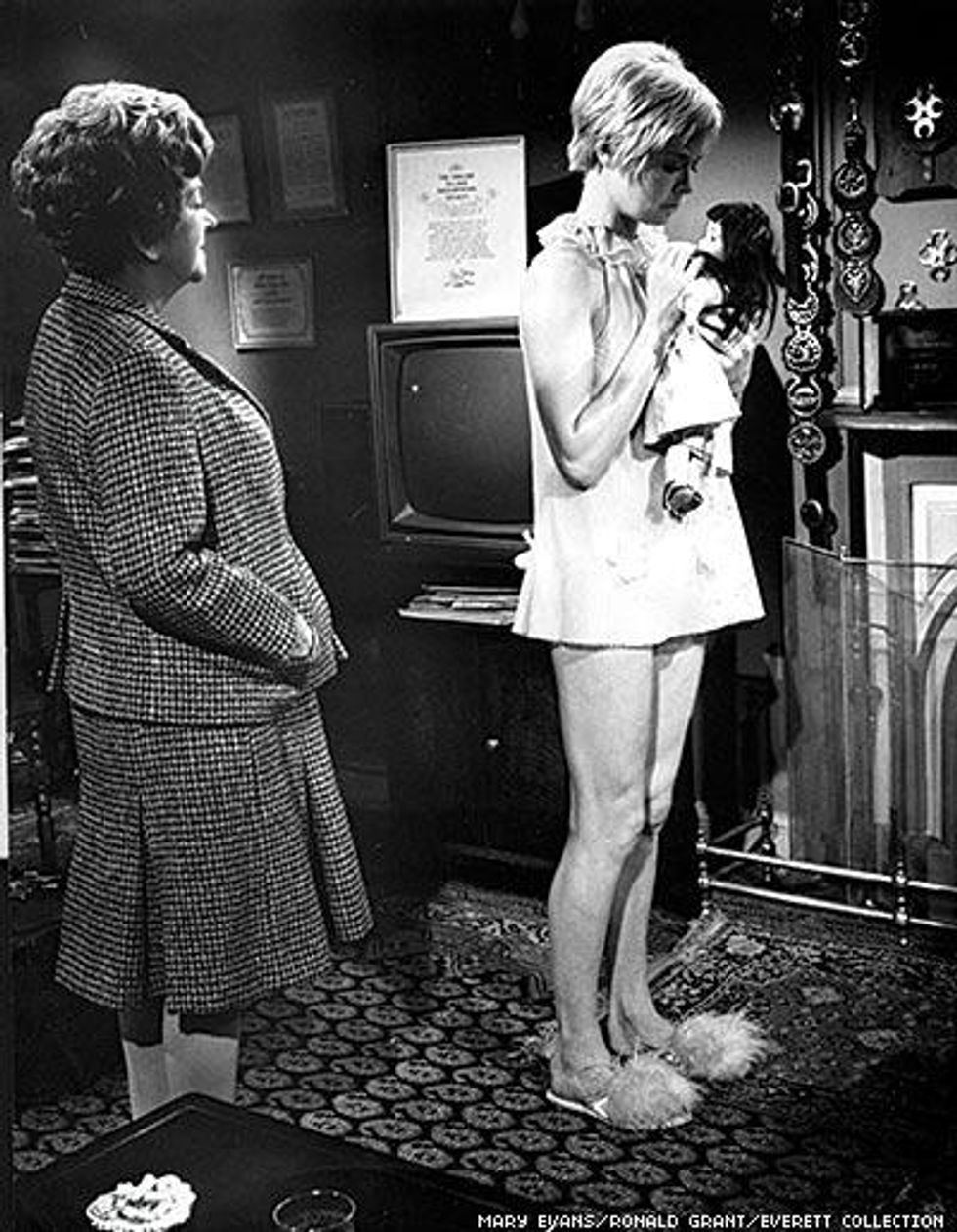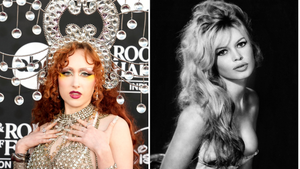Forty-seven years ago, The Killing of Sister George revolutionized the way lesbians are portrayed in the movies, changed the way films are advertised, and, thanks to a sex scene that was considered "startling" at the time, earned one of the Motion Picture Association of America's first X ratings. It's mentioned in every serious history of queer cinema, but these days, because it isn't available on a streaming service and because video stores have become almost as rare as lesbian bars, it is seldom seen. That needs to change.
In 1968, the film was mocked by straight critics and vilified in the lesbian press, but those harsh judgments reflected the attitudes of the time. From the perspective of 2015, The Killing of Sister George is both a fascinating chronicle of lesbian London in the swinging '60s and a bracing reminder of how hard it has always been to live an openly gay life.
The carnage of the title is the impending death of a beloved country nurse on a popular TV soap opera. June Buckridge (Beryl Reid), the middle-aged actress who plays Sister George -- and is known to one and all by her character's name -- is convinced she's going to be axed when she receives a visit from no-nonsense BBC executive Mercy Croft (Coral Browne) at the flat she shares with her girlfriend, Alice McNaught (Susannah York). In fact, Croft has merely come to chastise George for a drunken incident involving a pair of nuns and a taxi, but a few days later, she confirms that George is being written out of the show. She then compounds George's misery by seducing Alice.
While many aspects of Sister George's reputation are ripe for rehabilitation, it would be silly to suggest that the movie presents lesbian relationships in an entirely positive light. George is a hopeless alcoholic with anger issues; she's jealous and suspicious of Alice -- known as "Childie" for her immature manner -- and while it gradually becomes clear that she genuinely loves Childie, they spend most of their time together bickering. George takes pleasure in punishing Childie for tiny offenses -- at one point forcing her to eat the butt of her cigar.
It's easy to see why some lesbians were uncomfortable with this representation of their kind. In the lesbian publication The Ladder, one writer fretted that the film would "confirm the general public in its outdated and patronizing, if not hostile, conception of lesbians" and called for it to be picketed. In the same issue, a reviewer wrote that The Killing of Sister George "has almost as much relationship to the life of the ordinary lesbian as Donald Duck has to an ordinary man." With a mixture of anger and sadness, she condemned "movies that appear to deal with lesbians, seen entirely through the eyes of heterosexual males."
It's true that The Killing of Sister George was created by a team of straight men, and while they may not have been experts on lesbianism, they at least understood what it means to be scapegoated and persecuted. Frank Marcus, who wrote the play the movie was based on, and Lukas Heller, who penned the screenplay, were both Jews who had fled Germany. Robert Aldrich, who directed and produced the movie (as well as camp classics like What Ever Happened to Baby Jane? and Hush...Hush, Sweet Charlotte), was a cousin of future vice president Nelson Rockefeller's, but he was disinherited by his wealthy family after he dropped out of college to work in Hollywood.
Aldrich made a major contribution to the preservation of lesbian history when he filmed a key scene in the Gateways, a lesbian club that operated in London between 1931 and 1985, and used 40 members as extras. At the Gates, as it was commonly known, George and Childie perform a comedy routine dressed as Laurel and Hardy, then a fab four-piece combo performs pop hits for dancing. It now feels miraculous to get a glimpse at the decor of this long-shuttered venue, to see the clothes and haircuts favored by the patrons, and to marvel at their dance moves. Amazingly, the film used the club's real name and address. As music journalist Val Wilmer explained in her memoir, for years the Gateways' address was "whispered collusively...between women throughout the country"; The Killing of Sister George shared the location of this Sapphic paradise with the entire world.
Although it made him no friends at the time, Aldrich was determined to show lesbians as sexual creatures. Consequently, the film added a love scene between Childie and Croft that hadn't been present in the play. This led to its being awarded an X rating from the newly established MPAA. (Even so, the scene was cut in several states.) Aldrich challenged the rating and sued several Los Angeles media outlets that refused to run an ad for the movie just as he submitted it. He lost the case, which established the precedent that still allows newspapers across the country to edit movie advertising to reflect their market's tastes and "moral standards."
 At right: Beryl Reid and Susannah York in The Killing of Sister George
At right: Beryl Reid and Susannah York in The Killing of Sister George
Some critics claimed Sister George was an exercise in dykesploitation and suggested that the lawsuits were just part of Aldrich's marketing campaign. The Saturday Review said: "Aldrich obviously couldn't care less about the problems of Lesbian ladies or aging character actresses. He was out to earn his 'X' rating, and he has." That seems unfair: In The Celluloid Closet, Vito Russo reported that Aldrich offered to make cuts to avoid an X certificate but was told that the MPAA's president had already decided "it gets an X no matter what you do to it."
Whatever Aldrich's motivations, the two-minute sex scene became both a target for censors and an object of mockery from the critics. Writing in the New York Times, Renata Adler said that Croft "approaches [Childie's] breast with a kind of scholarly interest, like an ichthyologist finding something ambivalent that has drifted up on the beach," while John Simon likened the breast fondling to "testing a particularly inscrutable cantaloupe for its ripeness." Viewed today, the scene still seems cold and unsexy. Nevertheless, it does show two mature women -- Childie was in her 30s, Croft in her 50s -- having sex to the point of orgasm. That was revolutionary in 1968, and it's hardly commonplace in the movies and television of today.
George is without a doubt the hero of the film. She consistently refuses the protection of the closet -- making no attempt to convince her employer that her girlfriend is a mere flat mate and proudly announcing that she plans to spend the evening at London's most notorious lesbian nightspot. She is an unapologetic old-school butch who clomps about in comfortable tweeds, drinks pints of beer, and decorates to suit her tastes, even if they seem unacceptably masculine to others. When she isn't depressed and drunk, George is kind, fun, and vibrant.
The movie even shows an appreciation of lesbian aesthetics when an attractive young woman at the Gates tells a friend she prefers George to Childie. Yes, George is a victim -- she loses her job, sacrificed to give a short-term boost to the soap opera's ratings -- and in the final scene, she's alone and unemployed. But she still has her integrity, and in the world of The Killing of Sister George, that's a rare commodity indeed.
June Thomas writes about culture for Slate and edits Outward, the magazine's LGBTQ section. A native of Manchester, England, she now lives in Brooklyn.
The Killing of Sister George Trailer by lesbianmovies


 At right: Beryl Reid and Susannah York in The Killing of Sister George
At right: Beryl Reid and Susannah York in The Killing of Sister George

































































Charlie Kirk DID say stoning gay people was the 'perfect law' — and these other heinous quotes